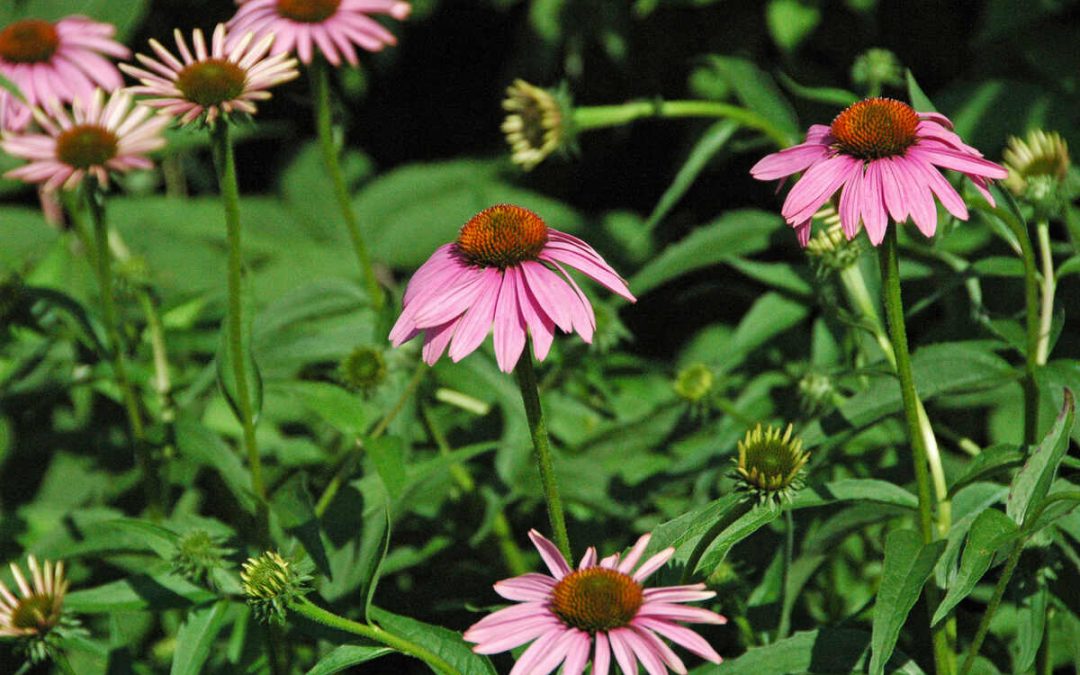From the educational exhibits and programs at Great Plains Nature Center to the beaches, hiking, and fishing available at Lake Shawnee, Kansas is home to many places to learn about and enjoy nature. You can continue to enjoy nature and celebrate it by creating a home environment filled with the best native plants for Kansas. Keep reading to find out the 10 best native plants to create a beautiful and diverse home garden.
Native plants not only promote biodiversity and support the local ecosystem, but they can also reduce the amount of time you spend on upkeep. Because they have adapted to the local climate, native plants typically require fewer waterings, fertilizers, and other maintenance tasks than non-native plants.
In this article:
- Butterfly Milkweed
- Largeflower Tickseed
- Cardinal Flower
- Purple Coneflower
- Showy Goldenrod
- Little Bluestem
- New England Aster
- Fall Phlox
- Pink Ladies
- Spicebush
- How to Choose Native Plants for Your Kansas Landscape
- FAQ About Native Kansas Plants
- Where to Find Native Plants in Kansas
10 Best Native Plants for Your Kansas Yard
1. Butterfly Milkweed (Asclepias tuberosa)
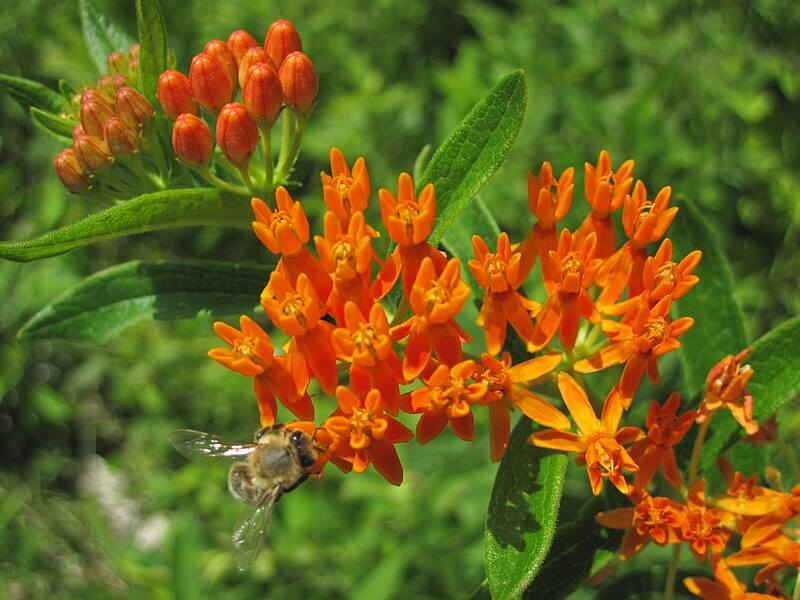
Photo Credit: James St. John / Wikimedia Commons / CC BY 2.0
Butterfly milkweed, also known as butterfly weed, has bright orange flowers and wide green leaves that are an attractive addition to any native plant garden. However, all parts are poisonous if ingested. Butterfly milkweed is also an eye and skin irritant. As lovely as these summer blossoming flowers are, take precautions if you plant this herb and you have children or pets.
Butterfly milkweed embraces stability and does not transplant well once planted. It requires minimal maintenance and is pest and disease tolerant. Milkweeds are crucial for the survival of the monarch butterfly. Their population has reduced significantly in the past two decades. Plant this herb in borders or a butterfly garden and proudly support your local ecosystem.
Native Regions: Most areas of Eastern and Central Kansas and limited areas of Eastern Kansas
Plant type: Perennial herb
USDA Hardiness Zone: 3 to 9
Sun: Full sun
Soil: Clay, loam, sand
Duration: Perennial
Fragrance: Vanilla
Bloom time: May to September
Water needs: Low
Mature height: 1 to 2 feet
Potential hazards: Poisonous to animals and humans if ingested. Possible skin and eye irritants if touched.
Maintenance: Low
2. Largeflower Tickseed (Coreopsis grandiflora)
This beautiful herb has no shortage of fluffy-looking, striking yellow flowers. The petals are layered on top of each other, although you can also find them arranged side by side like a saucer with a slight upward bend.
Largeflower tickseed is indeed a large flower, measuring two inches across. This easy-to-grow flowering herb attracts butterflies and bees. It prefers full sun and is especially ideal for the South Central area.
Once established, tickseed will survive off the area’s rainfall and may require watering once biweekly, at the most. This herb has also proven to grow well in the droughts of Northwestern Kansas. Plant it in cottage gardens or use it as an accent plant or container plant.
To enjoy blossoms from late spring to late summer, remove the spent flower shoots.
Native Regions: Limited counties in all regions
Plant type: Herb
USDA Hardiness Zone: 4 to 9
Sun: Full sun
Soil: Well-drained, sand, loam, clay
Duration: Perennial, biennial
Foliage: Semi-deciduous
Fragrance: Sweet, spicey
Bloom time: Summer and fall
Water needs: Drought tolerant, 1 inch per week
Mature height: 1.5 to 2.5 feet
Potential hazards: Some people are allergic to tickseed. This herb is susceptible to fungal diseases such as powdery mildew. Tickseed may attract aphids, aster leafhoppers, or coreopsis beetles.
Maintenance needs: Low-maintenance, fertilize and deadhead to encourage robust blooms.
3. Cardinal Flower (Lobelia cardinalis)
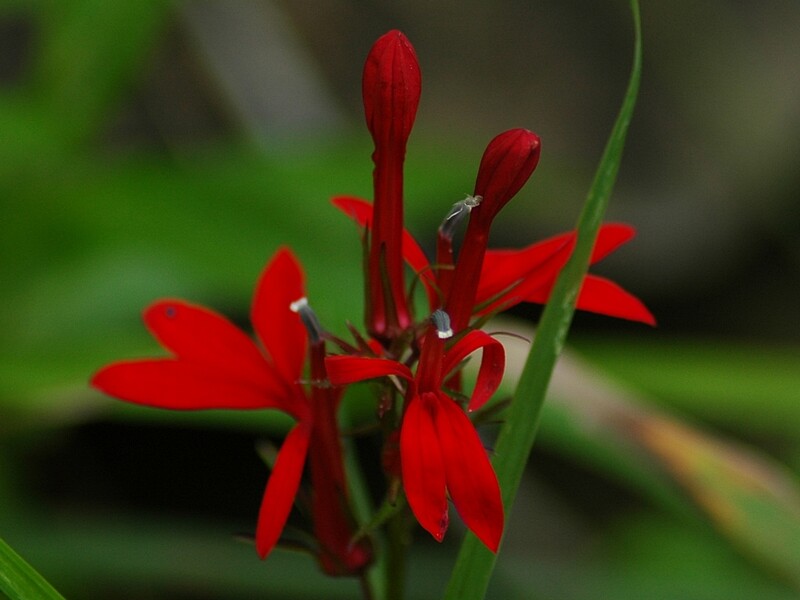
Photo Credit: linnaeus / Wikimedia Commons / CC BY 3.0
Looking for a blast of fall color? This richly red flower blooms from midsummer to early fall. It enjoys moisture so much that it withstands brief flooding. If you are looking at low-maintenance landscaping ideas like rain gardens and xeriscaping, cardinal flower is a good choice.
Be mindful of its toxic potential. It’s harmful if large quantities are ingested.
Hummingbirds and butterflies are attracted to this flower. Cardinal thrives in full sun but expects afternoon shade to grow at its best. If your soil remains wet, your property is a good home for this flower.
Apply root mulch during the cold Kansas winters to protect cardinal flower’s root system and ensure sufficient room for the roots to grow.
Native Regions: Select counties in all regions
Plant type: Flower
Hardiness zones: 3 to 9
Sun: Full sun, partial shade, full shade
Soil: Sand, loam, clay, limestone-based
Duration: Perennial
Fragrance: No floral scent
Bloom time: Fall and Summer
Water needs: Medium to high
Mature height: 1 to 6 feet
Potential hazards: Toxic if large amounts are ingested
Maintenance: Low
4. Purple Coneflower (Echinacea purpurea)
Purple coneflower is also called pink double delight. It has small-petaled reddish or purple flowers that look like little pom-poms that sit atop longer petals of the same color.
Purple coneflower is a favorite for homeowners wanting to see magnificent color during the cold Kansas winters. The pink double delight continues to bloom until frost.
Purple coneflower looks great in borders, beds, and wildflower gardens. It is deer resistant and tolerant of pests and diseases. This flower is very low maintenance and is even known to grow well when neglected.
Native Regions: All
Plant type: Flower
USDA Hardiness Zone: 3 to 8
Sun: Full sun, partial shade
Soil: Sandy
Duration: Perennial
Fragrance: Light, sweet, honey-like
Bloom time: April to September
Water needs: Medium
Mature height: 2 to 5 feet
Potential Hazards: None; has medicinal properties
Maintenance: Low
5. Showy Goldenrod (Solidago speciosa)
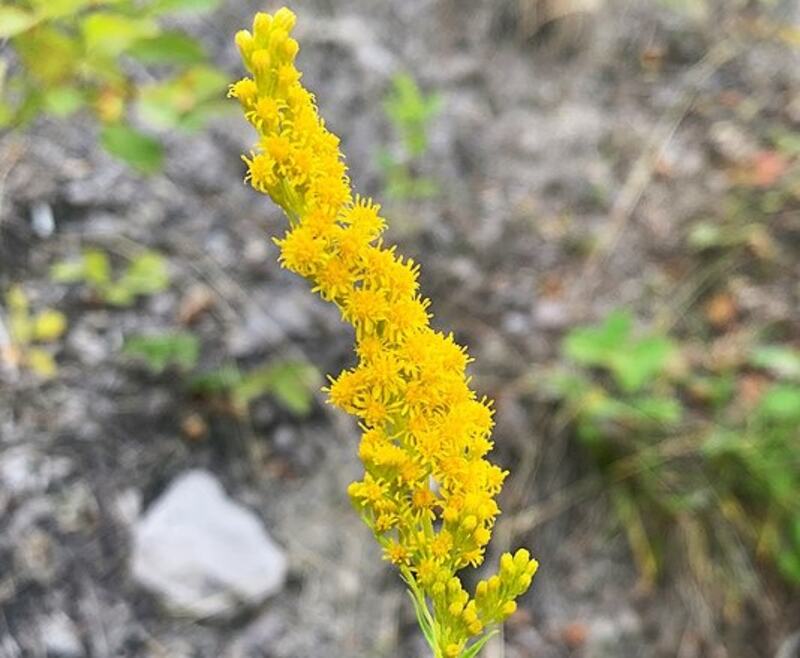
Photo Credit: Dseiver / Wikimedia Commons / CC BY-SA 4.0
These yellow flowers cluster near the top of upright stems that reach up to five feet high. Showy goldenrod catches the attention of butterflies, bees, and birds. This flower has a rating of medium flammability, so it is not the best plant to place near the barbeque grill or outdoor fire pit.
Showy goldenrod thrives on properties with a lot of sun or partial shade. You will not have to water it much, as it is drought-tolerant once established. Add it to cottage gardens or borders. It’s not picky about soil choice, but moist soils may cause this showy wildflower to become aggressive.
Native Regions: Select areas of Eastern and Central Kansas; not native to Western Kansas
Plant type: Flower
Hardiness zones: 3 to 8
Sun: Full sun, partial shade
Soil: Rocky, clay
Duration: Perennial
Fragrance: Mild
Bloom Time: July to September
Water needs: Low to medium
Mature height: 1 to 5 feet
Potential hazards: Medium flammability
Maintenance: Low to Medium; May have to divide it every 2 years for size management.
6. Little Bluestem (Schizachyrium scoparium)
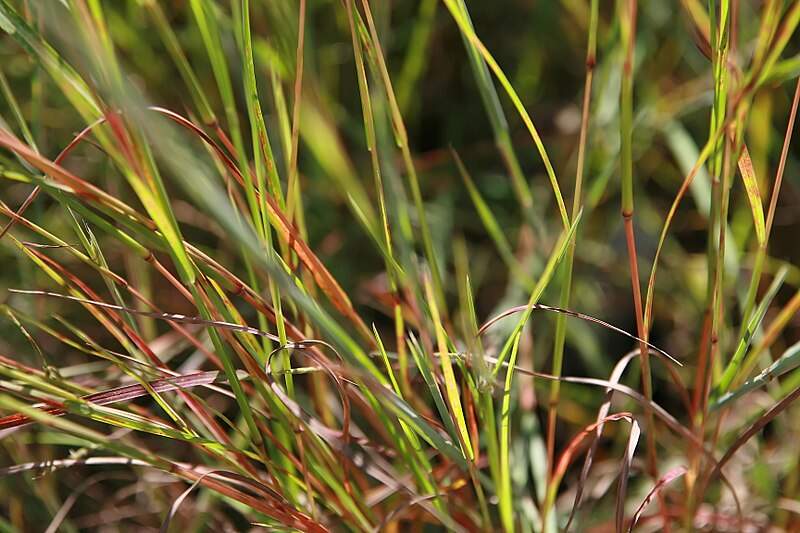
Photo Credit: David J. Stang / Wikimedia Commons / CC BY-SA 4.0
Ready for a little winter color? Little bluestem is blue-green in the summer, yellow-orange in the fall, and copper in the winter.
This plant is very adaptable and thrives in the wetter and drier areas of Kansas. It is humidity, heat, and drought-tolerant. Bluestem is easy to grow and will do well in a yard that gets a lot of sun.
Because it is drought-resistant once established, little bluestem is ideal for rock gardens. Plant it on slopes to take advantage of its erosion control properties. Little bluestem is classified as a warm-season grass, so it is a great choice for a low-maintenance groundcover to replace turfgrass in lawns.
Native Regions: All
Plant type: Ornamental grass
USDA Hardiness Zone: 3 to 9
Sun: Full sun
Soil: Dry to moist, well-drained soils
Duration: Perennial
Bloom time: August – February
Water needs: Low
Mature height: 2 to 4 feet
Maintenance: Low
7. New England Aster (Symphyotrichum novae-angliae)
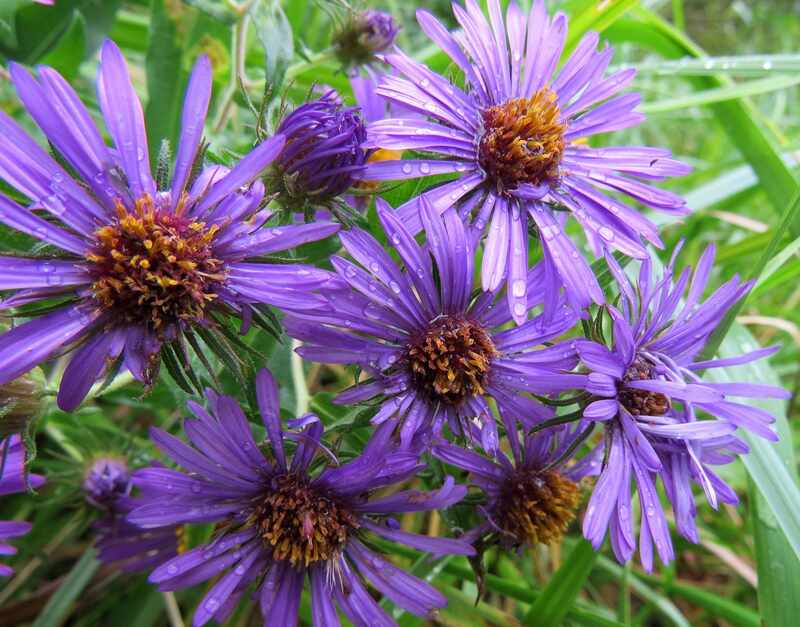
Photo Credit: USFWS Midwest Region / Flickr / Public Domain
New England aster is another plant that adds a little fall color. It blossoms for at least six weeks, starting in late summer. This flower looks like a daisy. It has pink petals emerging from a yellow center. Dark green leaves grow on stems that stand three to six feet tall.
New England aster’s roots have been used for medicinal purposes, and it’s naturally found in moist soil or drying sandy soil.
This daisy imposter attracts butterflies and bees. Plant it in butterfly gardens and cottage gardens and give it space for adequate air circulation.
Native Regions: Eastern Kansas; not native to Central and Western Kansas
Plant type: Flower
USDA Hardiness Zone: 4 to 8
Sun: Full sun to partial shade
Soil: Clay, sandy, loamy
Duration: Perennial
Bloom time: Late summer – early fall
Water needs: Medium
Mature height: 3 to 6 feet
Potential hazards: Nontoxic
Maintenance: Medium. If it grows tall, it may require staking or other support. Pinching back stems before midsummer controls plant height and promotes flower growth.
8. Fall Phlox (Phlox Paniculata)
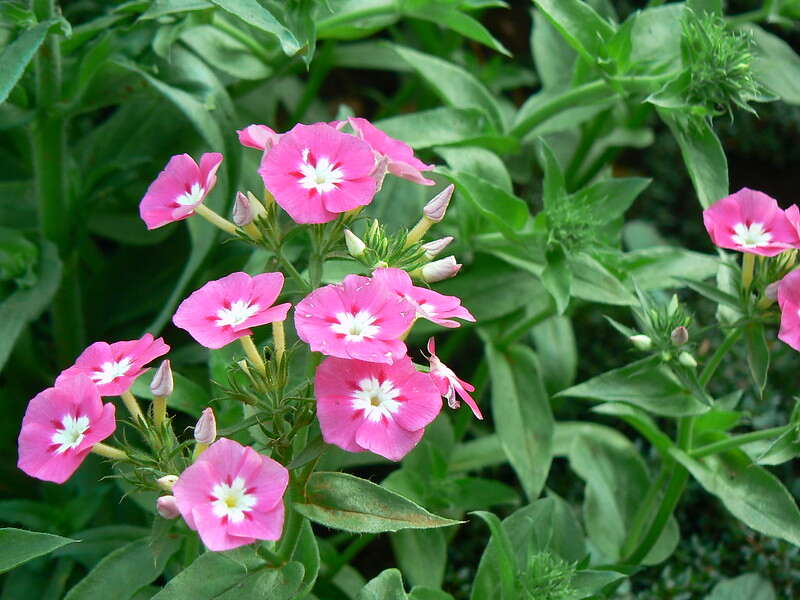
Photo Credit: Dinesh Valke / Flickr / CC BY-SA 2.0
Fall phlox has small white flowers that clump together atop stems with dark green leaves. The flower opens to show a yellow center.
Like New England aster, fall phlox needs space for good airflow. Although this herb is a breathtaking display, she takes some extra work to maintain because of her high susceptibility to diseases and pests. For example, to manage her risk of powdery mildew, plant her so that she receives adequate air circulation. Do not water her from the top, and remove her from the garden in the winter.
Despite all the fuss she causes, fall phlox is a great choice for pollinator gardens and in perennial borders. She also supports the ecosystem by attracting hummingbirds, butterflies, and other birds.
Native Regions: South Central, Northwest, and limited areas of Eastern Kansas
Plant type: Perennial herb
USDA Hardiness Zone: 4 to 8
Sun: Full sun to partial shade
Soil: Chalk, clay, loam
Duration: Perennial
Fragrance: Sweet scent
Bloom time: June – October
Water needs: Medium
Mature height: 2 to 4 ft
Potential hazards: No hazards
Maintenance: Medium
9. Pinkladies (Oenothera speciosa)
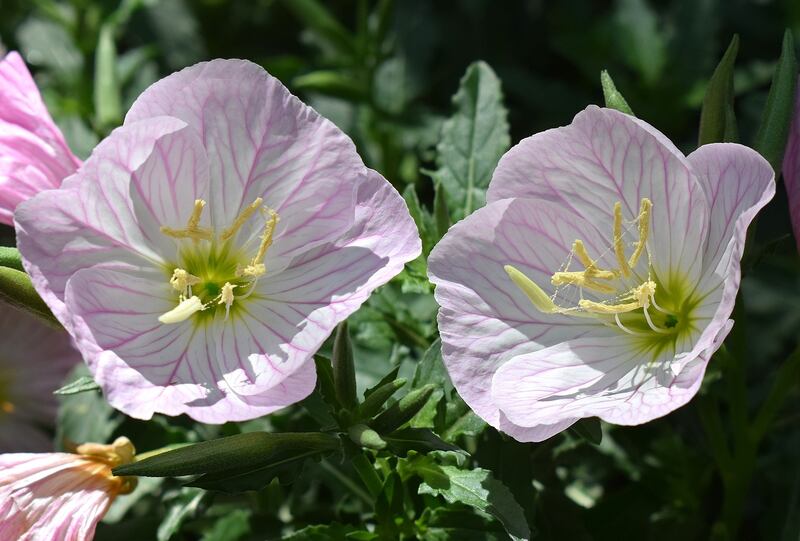
Photo Credit: Pixabay
Pinkladies, also called Mexican primrose, have four large white petals. You may also see her boasting pink petals. In either case, she has a yellow center and white stigmas. The stems are erect, and this showy herb beckons hummingbirds, bees, and hawk moths to pollinate the petals.
Although she requires full sun, she tolerates a variety of soils. If you have a lot of shade and poor soil, pink ladies will understandably adapt.
She works well in coastal gardens and wildflower gardens. Because this herb tolerates drought, she is a good choice for rock gardens. Mexican primrose can get beside herself and become invasive. As a result, she is earmarked as an excellent option for groundcover.
Native Regions: Southeast and most of Eastern and Central Kansas; limited areas of Northwest Kansas
Plant type: Herb
USDA Hardiness Zone: 3 to 9
Sun: Full sun
Soil: Well-drained sand, loam, clay, or rocky soil
Duration: Perennial
Foliage: Semi-evergreen
Fragrance: Sweet
Bloom time: February – October
Water needs: Low-Medium, Drought-resistant
Mature height: 1 to 2 feet
Potential hazards: None known
Maintenance: Plant in a confined space to prevent overgrowth. Prune or mow in late summer or early fall.
10. Spicebush (Lindera benzoin)
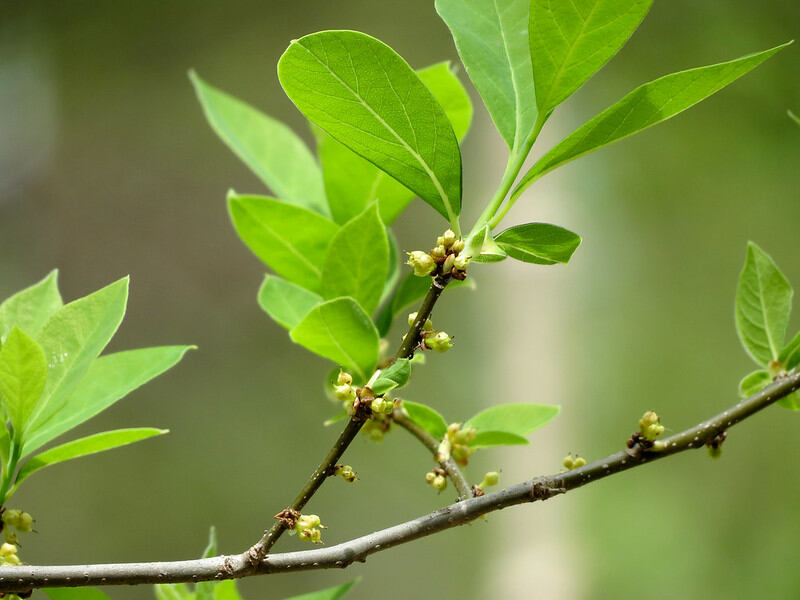
Photo Credit: Katja Schluz / Flickr / CC BY 2.0
If you’re looking for a tall shrub, look no further. Spicebush grows up to 12 feet tall. She is known for her small yellow flowers that sprout in early to mid-spring and red berries that follow. The ripe berries attract small mammals and birds in the fall. The flowers are prey to pollinators and butterflies. The twigs and leaves have been used for medicinal purposes and teas, and the fruit has been used as a spice.
Woodland gardens and rain gardens provide a wonderful spot for spicebush to showcase her fall color.
Native Regions: Select areas of Southeast Kansas; not native in other areas
Plant Type: Shrub
USDA Hardiness Zone: 4-9
Sun: Full sun to partial shade
Soil: Moist but well-drained clay, loam, or sandy soils
Duration: Deciduous
Fragrance: Allspice
Bloom Time/Season of Interest: Spring and autumn
Water Needs: Moderate to high
Mature Height: 6-12 feet
Potential Hazards: None; all parts of the plant aside from the roots and stems are edible and female plants have edible berries
Maintenance Needs: Low
How to Choose Native Plants for Your Kansas Yard
You’ll want plants with the necessary hardiness to survive the hot Kansas summers, cold winters, multiple soil types, and varying rainfall levels. Choose plants that are most likely to thrive in your area of the state. Plants not native to your area may still grow well, but it may take more maintenance to keep them alive and thriving.
Some other things you can do to choose the best native plants are:
- Choose plants in your region’s USDA hardiness zone. These zones identify plants that will survive the area’s lowest average temperatures. Your zone should fall somewhere within 5a to 7b, which are the zones for the state of Kansas.
- Select plants that fit well with your yard’s characteristics. Is your yard sunny or shady? Is your soil well-drained or does it tend to hold on to moisture? Knowing these things can guide you to plants that are better suited for your home’s conditions.
- Pick plants that compliment your lifestyle. If you don’t have a lot of time for maintenance, plants that require little to remain healthy are the best option.
- Choose plants that work well with your family composition. You can opt for plants that have safety precautions if you have pets or small children. However, be mindful that you may want to plant them behind a fence or make sure you don’t leave small children or pets unattended when they’re outside.
Research can be your best friend. Gather all the information necessary to make sure your vegetation is a practical fit for your yard’s conditions, your maintenance preferences, and your family composition.
FAQ About Native Kansas Plants
Here are some benefits of using native plants:
• Native plants are adapted to the Kansas climate. They will still require some maintenance to be healthy, but they require less watering, fertilizing, and other tasks that may be necessary to keep non-native plants thriving.
• Native plants are adapted to local diseases and pests. These plants require fewer, if any, chemical treatments, like pesticides and fungicides, to manage infestations and insect problems.
• Because fewer pesticides, fertilizer, and other toxic substances are needed on native plants, fewer chemicals run off into the water supply.
• Native plants support the local ecosystem by providing food and habitat to local pollinators, insects, and wildlife.
• Blue lobelia (Lobelia siphilitica)
• Missouri evening primrose (Oenothera macrocarpa)
• Rose verbena (Glandularia canadensis)
• Smooth aster (Symphyotrichum laeve)
• Pussytoes (Antennaria parlinii)
• Virginia bluebells (Mertensia virginica)
• Boneset (Eupatorium perfoliatum)
• Eastern blue star (Amsonia tabernaemontana)
• Purple coneflower (Echinacea purpurea)
• Beebalm (Monarda bradburiana)
• Royal catchfly (Silene regia)
• Trumpet honeysuckle (Lonicera sempervirens)
• Maiden grass (Miscanthus sinensis)
• Wintercreeper euonymus (Euonymus fortunei var. coloratus)
• Purple beautyberry (Callicarpa dichotoma)
• Chinese wisteria (Wisteria sinensis)
• Shrub rose (Rosa spp.)
Where to Find Native Plants in Kansas
You probably already know you can find native plants at The Wichita Gardens. But if you want native plants to start your own garden, the Kansas Native Plant Society has information on native plant sales, nurseries, and more.
You now have the resources to create a home environment that provides habitats and food sources for local pollinators and insects. Let’s get you over to the Kansas City Zoo to see wildlife that you won’t see, and probably don’t want to see, visiting your property. (The zoo is for little and big kids, which includes you.) Hand over your outdoor mowing, edging, and trimming chores to a local lawn care pro so you can do something else.
Main Image Credit: Purple Coneflower / James St. John / Flickr / CC BY 2.0

